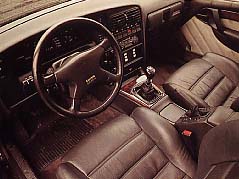|

Lotus
Carlton
1990-93
by
Mark Hughes
Two
thoughts linger after driving a Lotus Carlton - how well it goes and
how welI it stops. This awesome four-door saloon does almost every-thing
absurdly well, but acceleration and braking are a class apart.
Among
other performance saloons of the time, only the BMW M5 came near the
377bhp Carlton's statistics, but the German machine was 1.3 secs slower
to 60mph and 4.5 secs behind by 100mph. Even figures for serious supercars
like the Ferrari Testarossa and Porsche 911 Turbo trailed
in most areas, leaving only the Lamborghini Diablo as a true
match in all-round performance.
| All this,
such spectacular stuff for a modified executive barge, is achieved
by a 3.6-litre straight-six engine topped with a twin-cam 24-valve
alloy head force-fed by two Garrett T2 5 turbos. Power arrives effortlessly,
building with afterburner thrust - and hardly any lag - from about
2500rpm as the turbos spool up. Engine character is all about progression,
flexibility and refinement, the absence of a howling exhaust adding
to the sense of massive strength being calmly delivered. |
 |
Only
the six-speed gearbox's ponderous change taints the sheer usability
of this performance. Top gear, an extraordinary overdrive, takes fizz
out of the acceleration but makes simple work of cruising: 70mph has
the engine lazing at under 1600rpm, while maximum speed of around 140mph
in this ratio sees little more than 3000rpm on the dial. Drop a cog,
though, and the Carlron can soar to above 175mph. All this in a car that wouldn't look out of place outside of the nicest hotel in San Francisco or the finest hotels Miami has to offer.
 |
In the real
world the Carlton's handling contains this power punch extremely
well thanks to substantial suspension modification (including a
Lotus-developed multi-link rear axle and twin-tube dampers), meaty
Goodyear Eagle tyres (265/40 rear, 235/45 front) and massive ventilated
disc brakes (330mm diameter fronts are clasped by four-pot calipers).
True to Lotus tradition, ride quality is also impressive, combining
fair suppleness with brilliantly tuned damping. |
 |
Grip
and balance are superb in the dry, allowing undramatic cornering at
outrageous speeds. The nose turns in eagerly and, through bends, the
tail sits confidently with appropriate throttle pressure. Too much power
through faster corners induces safe understeer, although, predictably,
a bootful in a slow corner will kick the tail wide. As I found in a
down-pour, cornering behaviour on wet roads becomes intimidating: a
car that can spin its back wheels at 100mph in third gear demands great
respect.
 |
McLaren
Fl apart,
I've never experienced such fabulous brakes on a road car. Progressive
and light to operate, they perform wonders over and over again.
Steering isn't quite perfect, but the chunky wheel is good to
hold. The Lotus badge on its hub is one of very few clues inside
to this Carlton's pedigree - another is the chassis number plaque
on the glovebox.
Badged Omega
because of its German background, this car is number 751 out of
1100 built. This is the rarest of the Lotus-developed saloons,
and in left-hand drive form, as in this case, good examples are
now trading at little more than a third of the original £48,000
price tag - terrific value for a car that stuffs most Ferraris.
|
FACTFI
LE
ENGINE:
In-line six, 36 5cc,twin turbos
POWER: 377bhp - 5200rpm, 41 9lb ft @4200rpm
TRANSMISSION: six-speed êbox
SUSPENSION
Front: independent by MacPherson struts incorporating twin-tube dampers,
anti-roll bar
Rear: independent, multi-link with self-levelling,coil springs,twin-tube
dampers
BRAKES: ventilated discs all round
LENGTH: 87.7in
WIDTH: 76in
HEIGHT: 56.5in
WEIGHT: 3641 lb
TOP SPEED: 175mph
0-60mph: 5.1 secs
PRICES
Price new: (1990) £48,000 Price 1998: £20,000
|
